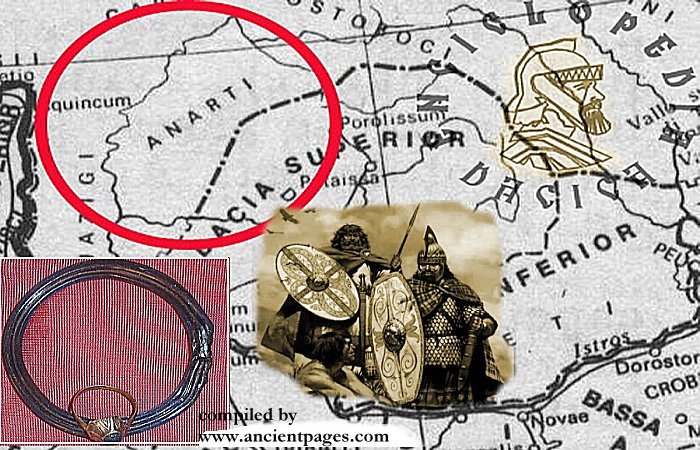A. Sutherland – AncientPages.com – The historical narrative of the Celts does not revolve around a singular ethnic group but rather encompasses the collective histories of various tribes that collectively formed a distinct Celtic culture.
It is an undeniable fact that numerous Celtic tribes have been lost to the annals of history, while others are merely known by their names.
Detail from the 9th European Map of a medieval edition of Ptolemy’s Geography, with the Celtic-Dacian Anartes tribe and the city of Docidava highlighted. image source
Among many tribes of the Celtic peoples, there is a major tribe of Anartes (Anarti, or Anartoi). According to scholarly research, the enigmatic Anartes are believed to have resided in the region of ancient Dacia, which encompasses the present-day territories of Romania, portions of Slovakia, and even certain areas of southeastern Poland.
Gaius Julius Caesar, the renowned Roman military leader and author, situated the territory of the Anartes along the eastern border of the Hercynian Forest. This enigmatic forest was a subject of intrigue, mentioned by notable figures such as Aristotle, Pliny the Elder, and Tacitus. Tacitus, in his seminal works ‘Germania’ (98 AD) and the ‘Annals of Tacitus,’ shed light on this mysterious woodland, adding to the historical accounts surrounding this ancient geographical feature.

Some decorations found at the foot of the Slonne Mountains in the town of Trepcza, Sanok County, San River, Subcarpathian Voivodeship by archaeologist Jerzy Ginalski. Image upploader: Mareksilarski – CC BY-SA 3.0
The forest was a very dark, dense, and unpenetrable place with bottomless bogs. It was an unknown realm, in which the rivers flowed northward, so vast in its extent that one could not go from one end of it to the other in sixty days’ march.
Among gigantic oaks with mighty intertwined branches, lived very strange animals, wrote Caesar in the sixth book of ‘Commentaries on the Gallic Wars. These animals were antlered elks and unicorns, the ancient ox called ‘aurochs and a beautiful bird with feathers that glowed like flames flitted among the numberless emerald leaves…’
This most unusual forest extended along with the Danube to the borders of the Daci and Anartes, according to Caesar’s description.
According to the available descriptions, the forest spanned ca. 225 km (nine days’ march) from north to south and extended over 1,500 km (sixty days’ march) eastward, stretching from the territory of the Helvetii to the lands inhabited by the Dacians in present-day Romania, the Anartes (Anarts) along the Tisza River in modern-day Hungary, and even farther beyond.
Assuming a day’s march covered a distance of 25 km the total area encompassed by the Hercynian Forest would have been a staggering 337,500 square km or even more. There is still the uncertainty surrounding the forest’s precise boundaries in the historical record.
In other words, the area of the forest was so large that it comprised the whole northern Danubian region from the Rhine and Danube in the west to Transylvania and the Carpathians in the east.

Celtic coin of the 3rd century BC from Trepcza, Sanok County, Subcarpathian Voivodeship, in south-eastern Poland. Depiction of Nike (reverse), 336-323 BC Greece, Macedonia, reign of Alexander the Great (336-323 BC). Image credit: Silar – CC BY-SA 3.0
The Hercynian Forest, an ancient woodland mentioned in historical accounts, remains shrouded in uncertainty regarding its precise boundaries.
The ancient Celtic history sheds light on the fate of the Anartes tribe, which was one of the rare instances where a tribe faced complete uprooting by the Romans.
As a punishment for their failure to provide military support to the renowned philosopher-emperor Marcus Aurelius (121 – 180 AD), the Anartes were forcibly relocated to one of the provinces bordering the Danube river. This event serves as a significant example of the consequences faced by tribes who defied Roman authority during that era.
Archaeological excavations conducted in the region have revealed that after migrating eastwards as far as Transylvania, the people encountered the Dacians, who were already settled in the area that would become their homeland. This discovery sheds light on the historical timeline and interactions between these two groups upon their convergence in the region.
The Dacians are believed to have shared ancestral ties with the Thracians, a non-Celtic ethnic group. Interestingly, the Celtic Anartes, who initially had a distinct cultural identity, eventually underwent a process of cultural assimilation and became integrated into the Dacian society over time.
This historical development highlights the dynamic nature of cultural interactions and the potential for diverse communities to merge and shape new collective identities.
Written by – A. Sutherland – AncientPages.com Senior Staff Writer
First version of this article was published on June 14, 2016
Copyright © AncientPages.com This material may not be published, broadcast, rewritten or redistributed in whole or part without the express written permission of MessageToEagle.com
Expand for references
References:
Tierney, J. J. “The Celtic Ethnography of Posidonius.” Proceedings of the Royal Irish Academy. Section C: Archaeology, Celtic Studies, History, Linguistics, Literature 60 (1959): 189–275.
Gaius Julius Caesar, The Gallic Wars (De Bello Gallico)






